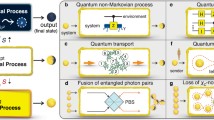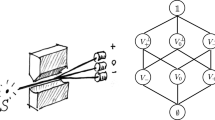Abstract
Relations occur on all levels of systems. Following a major assumption of generalized quantum theory, namely that the principles of quantum mechanics will occur on higher system levels as well, it was investigated in an a posteriori analysis of pre-existing data whether relational patterns found for two-photon experiments are similarly performed by two cell-populations. In particular, the typical pattern in outcomes of two-photon entanglement experiments was extrapolated to discover similar patterns of relationships in the cellular biological system of the Ciliate Paramecium caudatum. In the former case we find one photon assuming a particular state when being measured and the other assuming a correlated state with regard to the first particle. From a perspective of degrees of freedom (df) the author interprets this outcome as follows: Each particle has only one df for assuming a particular state (e.g. its spin). When measured this is leading to a pattern: They use their two degrees of freedom for establishing a relation among them (particle-to-particle) and for a relation with the environment (particle-to-measurement). If this pattern is unique then we should find it also in cell-to-cell relationships. It was suggested to consider causations in cell-to-cell relations as the analogue to the relationship between the quantum particles (see above) and the dependence of repeating the experiments as the analogue to the measurement event in the quantum experiment. It was hypothesized that in a relational system of two cell populations only one should be sensitive to the repetition of the experiment. The other population, however, should establish a relation with the first one. Since the author had successfully performed experiments with pairs of cell populations that were separated with glass barriers from each other but having effects on each other (Fels in PLoS One 4:e5086, 2009), the system was perfectly well suited for testing the hypothesis. The assessed cell variable was cell division. An a posteriori analysis of three similar experiments confirmed that when populations were in a relation with each other, only one of them stood in relation with the repetition of the experiment.


Similar content being viewed by others
References
Ananthaswamy A (2003) Entangled photons dance across the blue Danube. NewSci, p 15
SAS (2003) JMP statistics and graphics guide (Version 5.0.1.2). SAS Institute, CARY
Aspect A, Dalibard J, Roger G (1982) Experimental test of bell’s inequalities using time-varying analyzers. Phys Rev Lett 49:1804–1807
Atmanspacher H, Römer H, Walach H (2002) Weak quantum theory: complementarity and entanglement in physics and beyond. Found Phys 32:379–406
Fels D (2005) The effect of food on microparasite transmission in the waterflea Daphnia magna. Oikos 109:360–366
Fels D (2009) Cellular communication through light. PLoS One 4:e5086
Fels D, Kaltz O (2006) Temperature-dependent transmission and latency of Holospora undulata, a micronucleus-specific parasite of the ciliate Paramecium caudatum. Proc R Soc B 273:1031–1038
Julsgaard B, Kozhekin A, Polzik ES (2001) Experimental long-lived entanglement of two macroscopic objects. Nature 413:400–403
Kozlov AA (2000) The role of natural radiation background in triggering cell division. In: Beloussov L, Popp F-A, Voeikov V, van Wijk R (eds) Biophotonics and coherent systems. Moscow University Press, Moscow, pp 241–248
Mcfadden J (2000) Quantum evolution. Flamingo, London
Morowitz HJ (2002) The emergence of everything. How the World became complex, 1st edn. Oxford University Press, Oxford
Von Lucadou W, Römer H, Walach H (2007) Synchronistic phenomena as entanglement correlations in generalized quantum theory. J Conscious Stud 14:50–74
Von Stillfried N (2010) Theoretical and empirical explorations of “generalized quantum theory”. In Kulturwissenschaftliche Fakultät, Vol Ph.D. pp 236. Europa-Universität Viadrina, Frankfurt an der Oder
Von Stillfried N, Walach H (2006) The whole and its parts: are complementarity and non-locality intrinsic to closed systems? Int J Comput Anticip Syst 17:137–146
Wichtermann R (1986) The biology of paramecium, 2nd edn. Plenum, New York
Acknowledgments
The author is very thankful for motivation to Harald Walach, Thomas Filk and Nikolaus von Stillfried, which latter gave important comments on the earlier manuscript thus improving it. Further, many thanks for long talks to Walter von Lucadou, to Nigel Powell proofreading an earlier draft and to the constructive criticism of an anonymous reviewer of that earlier draft. And finally thanks to the laboratories (CNRS in Paris and former Swiss Tropical Institute in Basel) where I could perform the experiments.
Author information
Authors and Affiliations
Corresponding author
Rights and permissions
About this article
Cite this article
Fels, D. Analogy Between Quantum and Cell Relations. Axiomathes 22, 509–520 (2012). https://doi.org/10.1007/s10516-011-9156-x
Received:
Accepted:
Published:
Issue Date:
DOI: https://doi.org/10.1007/s10516-011-9156-x




